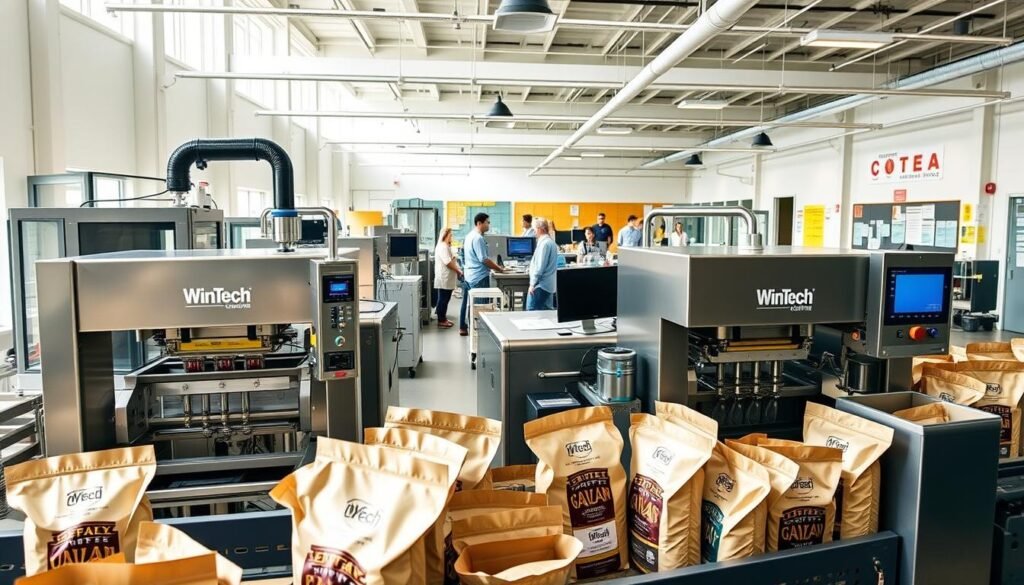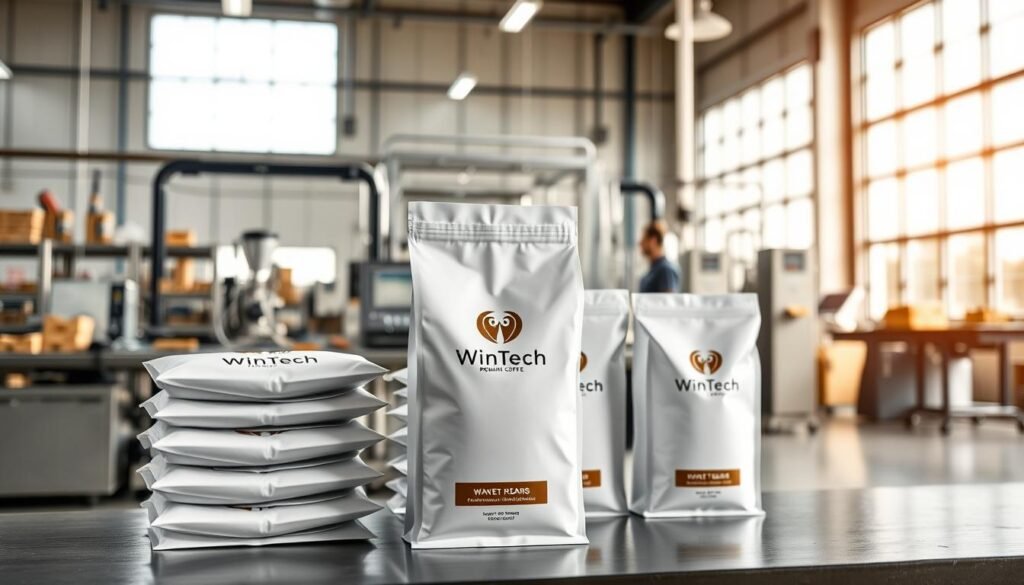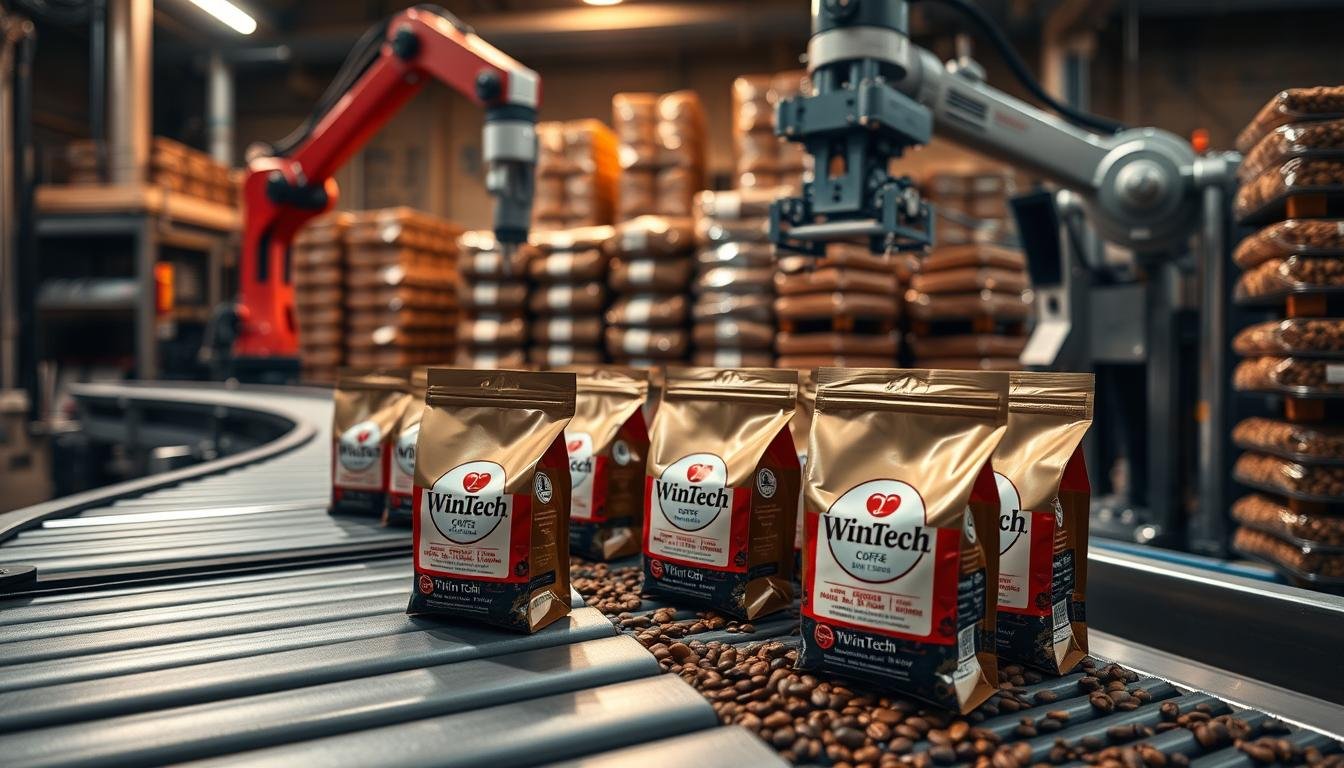Lean Manufacturing Principles Applied to the Packaging of Coffee Beans in U.S. Facilities
Have you ever wondered how your favorite coffee maintains its rich flavor from roasting to brewing? The secret lies in innovative Wintech packaging of coffee beans that transforms traditional manufacturing processes.
Lean manufacturing principles are revolutionizing the packaging of coffee beans across U.S. facilities. Companies like Wintech Package are implementing sophisticated vacuum sealed coffee packaging techniques that preserve coffee’s delicate characteristics while dramatically reducing waste and operational inefficiencies.
Your morning coffee’s quality starts with strategic whole bean storage methods. By integrating lean manufacturing strategies, coffee producers can ensure every bean reaches consumers with maximum freshness and optimal flavor profile.
Modern packaging of coffee beans requires precision, technological innovation, and a deep understanding of consumer expectations. Manufacturers are now using advanced techniques to protect coffee’s intricate sensory experiences from production to your kitchen.
Key Takeaways of Packaging of Coffee Beans
- Lean manufacturing transforms Packaging of Coffee Beans processes
- Vacuum sealed packaging preserves coffee quality
- Strategic storage methods protect bean freshness
- Technological innovations enhance packaging efficiency
- Consumer expectations drive packaging improvements
Understanding the Importance of the Packaging of Coffee Beans

Coffee packaging represents a critical intersection of science, design, and consumer experience. The right packaging can transform an ordinary coffee purchase into an exceptional journey of flavor and freshness. Understanding the nuanced requirements of coffee bean preservation has become a paramount concern for specialty coffee producers and consumers alike.
The Role of Quality in Packaging of Coffee Beans
Quality packaging plays a pivotal role in coffee freshness preservation. Wintech Package has pioneered advanced solutions that protect coffee beans from environmental degradation. Key considerations include:
- Preventing oxygen exposure
- Maintaining optimal moisture levels
- Protecting against light and temperature fluctuations
Degassing valve packaging has emerged as a revolutionary technique. These specialized valves allow carbon dioxide to escape while preventing external air from entering, ensuring your coffee remains at peak flavor potential.
Sustainability Considerations in the Packaging of Coffee Beans
Modern consumers demand environmentally responsible packaging solutions. Specialty coffee bags now incorporate:
- Biodegradable materials
- Recyclable components
- Reduced plastic usage
Consumer Preferences Affecting the Packaging of Coffee Beans
Today’s coffee enthusiasts seek packaging that communicates authenticity and quality. Transparent design, informative labeling, and eco-friendly materials have become essential markers of premium coffee experiences.
Innovations in the Packaging of Coffee Beans
Cutting-edge technologies are reshaping coffee packaging. Starbucks, for instance, has implemented advanced packaging processes that maintain bean integrity and enhance consumer interaction through intelligent design strategies.
The future of coffee packaging lies in balancing technological innovation with sustainable practices.
Lean Manufacturing Principles and Their Impact on the Packaging of Coffee Beans
Lean manufacturing has transformed the coffee packaging industry, bringing unprecedented efficiency to U.S. production facilities. By focusing on minimizing waste and maximizing value, companies are revolutionizing how coffee bean containers are designed and utilized.

The core of lean manufacturing in coffee packaging centers on strategic improvements that reduce unnecessary steps and enhance overall productivity. Manufacturers are now implementing sophisticated approaches to create more sustainable coffee packaging solutions.
Eliminating Waste in Coffee Packaging
Waste reduction is critical in coffee bean processing. Key strategies include:
- Optimizing airtight coffee storage systems
- Reducing material consumption
- Minimizing product handling
- Implementing precise inventory management
Streamlining Processes for Maximum Efficiency
Successful lean manufacturing requires continuous process refinement. Advanced coffee packaging facilities now utilize data-driven techniques to identify and eliminate inefficiencies.
| Process Improvement Area | Efficiency Gain |
|---|---|
| Packaging Design | 25% Material Reduction |
| Storage Optimization | 30% Space Savings |
| Production Workflow | 40% Time Reduction |
Enhancing Efficiency Through Technology
Modern coffee packaging facilities leverage cutting-edge technologies to achieve remarkable efficiency. Automated packaging systems and real-time monitoring tools enable precise control over production processes.
“Lean manufacturing is not just about reducing waste, but about creating value through intelligent design and continuous improvement.” – Manufacturing Expert
By embracing these principles, U.S. coffee packaging manufacturers are setting new industry standards for sustainable, efficient production.
Implementing Lean Strategies for the Packaging of Coffee Beans
Lean manufacturing principles have revolutionized the coffee packaging industry, offering innovative approaches to improve efficiency and product quality. U.S. coffee facilities are increasingly adopting strategies that transform how artisanal coffee packaging and whole bean storage methods are managed.

Successful implementation of lean strategies requires a comprehensive approach that goes beyond simple process modifications. It demands a holistic transformation of organizational culture and operational methodologies.
Training Employees for Optimal Performance
Effective employee training is crucial for successful vacuum sealed coffee packaging operations. Key training focus areas include:
- Understanding lean manufacturing principles
- Precision in packaging techniques
- Quality control mechanisms
- Waste reduction strategies
Continuous Improvement Framework
Continuous improvement represents the heart of lean manufacturing in coffee packaging. This approach involves:
- Regular process audits
- Employee feedback integration
- Technology adoption
- Performance benchmarking
Measuring Packaging Success
Tracking key performance indicators helps coffee packaging facilities optimize their operations. Critical metrics include:
| Metric | Target | Impact |
|---|---|---|
| Packaging Efficiency | 95% Accuracy | Reduced Waste |
| Product Freshness | 30-Day Preservation | Enhanced Quality |
| Packaging Speed | 50 Units/Hour | Increased Productivity |
By embracing these lean strategies, U.S. coffee packaging facilities can significantly enhance their operational effectiveness, product quality, and overall competitiveness in the market.
Future Trends in the Packaging of Coffee Beans
The packaging of coffee beans is rapidly evolving, driven by cutting-edge technologies and changing consumer expectations. You’ll see innovative approaches transforming how specialty coffee brands protect and present their products. Advanced techniques in coffee freshness preservation are becoming critical for maintaining the highest quality bean experience.
Sustainable coffee packaging is no longer optional but a strategic necessity. Brands are investing in eco-friendly materials that reduce environmental impact while ensuring product integrity. Specialty coffee bags now incorporate biodegradable components and recyclable designs, meeting the growing demand for responsible packaging solutions.
Technology plays a pivotal role in reshaping coffee packaging strategies. Smart packaging technologies can now monitor bean freshness, provide tracking information, and even suggest optimal brewing methods. Companies like Blue Bottle Coffee and Intelligentsia are leading the way in implementing these advanced packaging innovations that connect directly with coffee enthusiasts.
Market trends indicate consumers want transparency, sustainability, and premium experiences. Your future coffee packaging will likely feature QR codes revealing bean origins, roasting dates, and brewing recommendations. This digital integration transforms simple packaging into an interactive product experience that appeals to modern coffee lovers.
Technology’s Influence on Packaging
Emerging digital technologies are revolutionizing how coffee beans are packaged and presented. Sensors embedded in packaging can now track temperature, humidity, and freshness, ensuring you receive the highest quality product possible.
Eco-Friendly Materials
Sustainable packaging materials are becoming standard in the coffee industry. Brands are exploring compostable bags, renewable resources, and minimal waste designs that protect both your coffee and the environment.
Market Trends Shaping Packaging
Consumer preferences are driving significant changes in coffee bean packaging. You can expect more personalized, transparent, and technologically integrated packaging solutions that tell the story behind each bag of beans.
